Call me vain, but I do not like pain. Bees are beautiful and admirable creatures that are quite serious about defending their territory.
Even with docile bee races, you always run the risk of getting stung whenever you invade the hive, even though you may be doing it for their own good.
The good news is that keeping yourself protected is as easy as investing in and using the proper equipment.
Here, we’ll be getting more specific and discussing how you can protect your hands and forearms using a pair of great beekeeping gloves. Bees are a vital asset to have, for sure.
Still, you are even more valuable to your apiculture operation, and it’s important to keep your body sting-free with a pair of beekeeping gloves to ensure you remain as productive as possible.
This is especially true if you are a beekeeping beginner. Sure, there’s a lot of buzz about going gloveless if you are a “real” beekeeper. Getting stung doesn’t authenticate you. Hence, there’s no shame in having the best gloves for keeping bees.
|
5.0
|
4.6
|
4.6
|
|
$29.99
|
$17.95
|
$19.99 ($10.00 / Count)
|
3 Characteristics of Good Beekeeping Gloves
Besides the basics (durability, quality), there are a few factors one should consider in choosing excellent beekeeping gloves.
Good fit
Whereas we oversize the suit, the gloves we use for beekeeping need a snug fit.
To get through your activities in the hives, especially when handling bees, you need to be gentle.
That becomes difficult when dealing with beekeeping gloves that are a size or two too big.
A pair of beekeeping gloves that don’t fit well makes it easier to squash bees and increase your clumsiness.
In order to get the most out of your new beekeeping gloves, it is important that you get the right fit.
Where possible, try to buy the gloves locally so that you can try them on before you buy them to ensure they fit well.
If you purchase them online, use their hand chart to avoid losing time returning gloves that are either too large or too small, though they are rarely too small.

Non-slip Qualities
You need beekeeping gloves that will stay put as you work.
This is important as your apiary grows because you’ll have to spend more time working.
Depending on the material used to make the gloves, they will either need to have an extended sleeve to the elbow or be elastic in nature to ensure that it hug the wrist to keep it in place.
Fortunately, even without elastic, good old duct tape can help secure your gloves in the right place.
Sting protection
Ideally, what you’re looking for is the complete absence of stings on your bare hands and arms. The presence of gloves doesn’t keep the bees from trying. Thicker beekeeping gloves provide the best protection in this case.
A bee sting will get stuck in the glove, but it won’t penetrate far enough to get to the skin. As a result, you go about your business sting-free.
More experienced beekeepers favor
When the bees are calm, the threat of getting stung is reduced, which allows them to work comfortably with thin gloves or even no gloves at all.
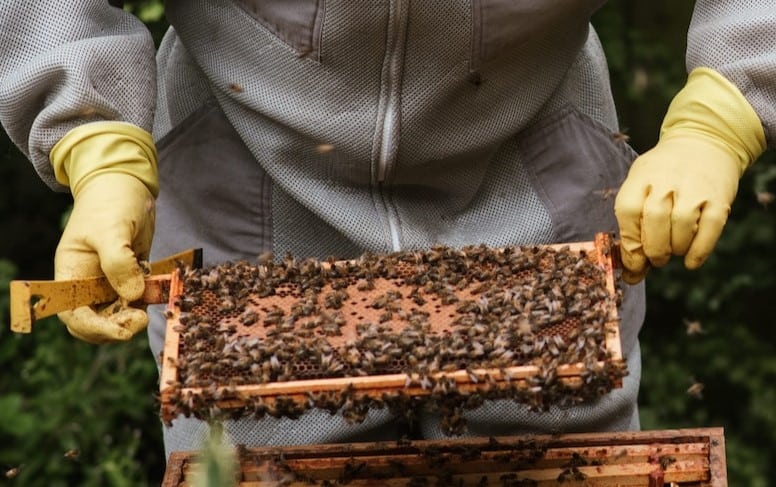
The 3 Best Types of Beekeeping Gloves That Keep You Stingfree and Dexterous
Below are the most recommended and common beekeeping gloves among beginners and experienced beekeepers alike.
This review comes from personal experience, so we kept the two most important factors when deciding what beekeeping gloves to get: The ability to offer maximum sting protection and dexterity.
Here are our favorite and best types of gloves to use when beekeeping.
1. Leather Beekeeping Gloves
Most beekeeping gloves available in the market are made of leather.
Cowhide tends to be thicker than Goatskin leather. The former is also more resistant to bee stings, but that also reduces your dexterity and makes it more difficult to work with the bees in your hive.
Having a thicker layer makes it harder to feel the bees and keeps you from accidentally crushing them.
Goatskin leather is a little thinner and offers a better fit while still thick enough to keep most bee stings away from the skin.
The advantage of using leather gloves for keeping bees is that they breathe because it’s a natural material. It’s also absorbent, so your hands won’t be sloshing around in a pool of your own sweat on a hot day.
There are lots of leather-made gloves in the market, so you will be spoiled for choice.
Some good alternatives of beekeeping gloves made of leather that you can choose from are:
- VIVO Bee – V103 Leather Beekeeping Gloves with Sleeves$14.99See on AmazonWe earn a commission if you make a purchase, at no additional cost to you.04/24/2024 08:04 am GMT
- Zamango 1 Pair Goatskin Beekeeper Beekeeping Protective Gloves$14.84See on AmazonWe earn a commission if you make a purchase, at no additional cost to you.04/24/2024 08:59 am GMT
These are affordable options that have a similar design.
The area around the hand is made of leather with a lighter, more flexible fabric, such as cotton or khaki, extending from the wrist to the elbow or close to it.
At the end of the sleeve, a bit of elastic holds the glove in place and helps keep the bees out.
The price is quite reasonable, and if treated well, they can give you years of good service.
Each brand may differ slightly from the other, but they have more similarities than differences.
2. Ventilated and Cuff Protected Beekeeping Gloves
I know, I know, it sounds like a marketing gimmick, but these gloves are useful. Ask anyone who gets sweaty palms at the thought of warm weather.
Beekeeping is only in the season when the weather warms up, so trust that you’ll be getting toasty in a bee suit and gloves in the summer as you harvest or keep tabs on your colonies.
Working with wet palms can be quite uncomfortable and difficult, so if you can stretch your purse strings a little, these added features will be helpful in the hot months.
In addition to ventilation, some of these gloves offer added protection around the cuff area and the arms. Why is this important?
When I was very new to beekeeping, I attempted to handle a colony of African bees that were particularly aggressive.
Short of an iron suit of armor, I was fully covered, yet I got quite a number of bee stings.
At some point, I noticed about 10 bees on the inner part of my wrist, and with all of them concentrated on one spot, I got a healthy dose of venom right on the pulse. The aftermath was not pretty.
Even though I had been stung before, this felt particularly painful because of how sensitive that area was.
I’m calmer and gentler with my bees now. If I could go back in time, I would grab myself a pair of these types of gloves.
3. Synthetic Rubber Gloves for Beekeeping (AKA Nitrile Gloves)
As you progress as a beekeeper and research some pieces of suitable hand-ware, you will undoubtedly come across strategies to wean yourself off gloves for beekeeping altogether.
They begin with the first type of gloves that we have covered, which are considerably thick.
You then ‘graduate’ to thin gloves such as the ones above, which come highly recommended among beekeepers, and for good reasons.
I must admit, these are surprisingly effective despite the miniature thickness of the material.
It’s not completely clear why the bees don’t sting as often through this synthesized rubber, but the running guess is that bees don’t recognize it as skin, so they don’t try to deliver bee stings through it.
That isn’t a guarantee that you won’t get stung because many have.
Because these gloves are thin, they allow you to carry out delicate tasks such as handling the queen.
If you consider the added dexterity and reduced ambition of the bees toward stinging you, these gloves are definitely worth a try.
Nitrile gloves are used mainly in the medical profession but are also popular among beekeepers too.
They are thicker than your regular latex gloves. Still, they offer your hands the same freedom to allow surgeon-like precision (pardon the pun).
Dishwashing Gloves
Dishwashing gloves also fall in this category and are quite popular.
They are more durable than their medically used counterparts and, therefore, cheaper in the long run.
Unlike leather gloves, they do not have elasticity, and they are not absorbent. As a result, you may have to either tuck them into a long-sleeved jacket or tape them to the sleeves of your suit.
You’ll also need to get used to the clammy feeling of working with sweaty palms, as the synthetic rubber does not breathe.
These gloves are disposable, which denies them any green points from the environment.
Even so, many beekeepers who switch from leather gloves to nitrile gloves hardly ever switch back to their previous gloves.
There are nitrile gloves that have longer sleeves and cover the wrist sufficiently.
Despite being disposable gloves, you can wash them and get multiple uses out of them.
Benefits of using Nitrile Gloves for Beekeeping
Apart from the ease with which you can handle the beekeeping equipment while wearing these gloves, they are easy to clean.
Dealing with wax and honey can cause an accumulation of goop.
Fortunately, because synthetic rubber doesn’t absorb water, they are very easy to wash, dry, and reuse.
It’s even possible to wash the gloves as you move from one hive to the other.
That minimizes the risk of spreading diseases and vectors within your apiary.
Try to do that with leather gloves, and you’ll have a soggy, clumsy exoskeleton that inhibits your progress.
How to Clean Your New Pair of Beekeeping Gloves (And Why You Should Care)
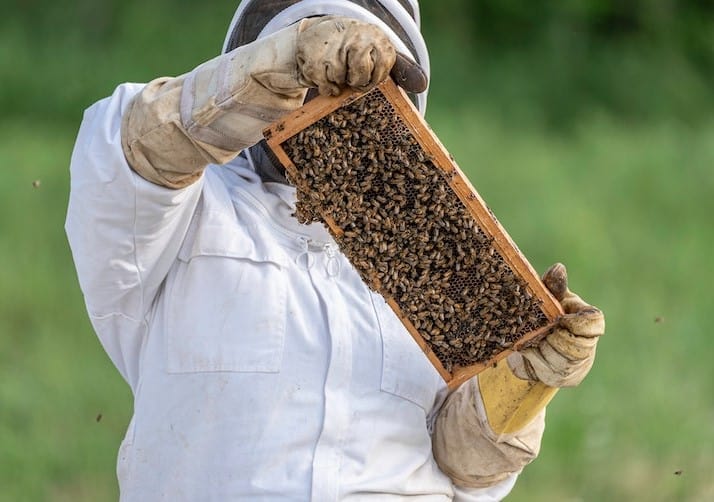
How about we start with why you need to keep your beekeeping gloves clean?
Aside from the stiffness derived from accumulated propolis, wax, and honey, stings left on the gloves from previous hive encounters leave a lingering pheromone that paints a bulls-eye on your hands.
The longer you continue to use the gloves, the more sting-happy the girls may appear to be, so it’s important to give them a good clean once in a while.
Nitrile-type gloves are as easy to clean as your hands. Some soapy water is all it takes to get them clean.
Leather gloves for beekeeping are a little more complicated. As a natural fabric, you need to be careful not to wear out the material.
Experienced beekeepers prefer to use solvents that dissolve the accumulated propolis, helping to separate the dirt without damaging the leather.
An example is a mineral oil laxative FGMO that dissolves the propolis and keeps the leather soft and malleable.
Another option is to put the gloves in the wash.
Propolis can be difficult to deal with, and it will stick to the side of the wash or attach itself to other pieces of clothing.
You’ll need to be careful about mixing your gloves with other garments. That could be a recipe for disaster.
There are those that use chlorine water, but being a bleaching agent will shorten the lifespan of your gloves.
Whatever treatment you choose should allow you to maximize the usefulness of your beekeeping gloves for as long as possible.
Wrapping Up Gloves for Beekeeping
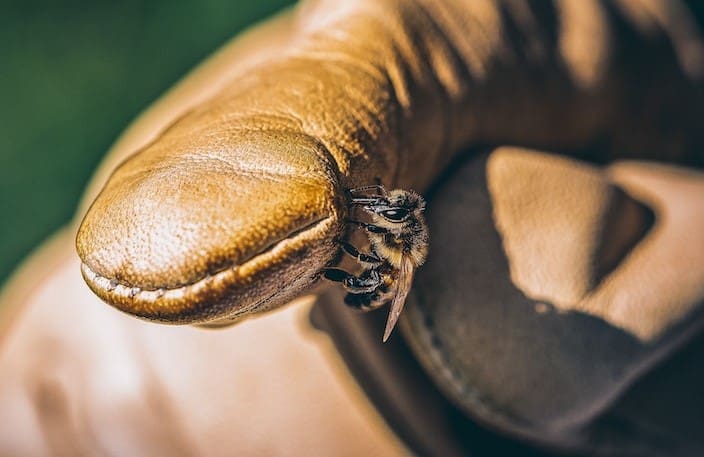
I find it interesting that beekeepers with decades of experience do not dissuade other beekeepers from using gloves.
In fact, they encourage it and will wear gloves themselves from time to time.
Those with a couple of years of experience seem to be the ones who push the idea that using gloves is tantamount to animal cruelty.
Your hands are very important tools, and they deserve to be free from strings and protected.
What works for one beekeeper may not work for you.
If one beekeeper swears that ventilated gloves are the only type worth wearing, yet your purse strings just won’t stretch that far, try a different type of glove. Just go through some online product reviews.
Here’s the truth about reviews for beekeeping gloves: one person wants to kiss the manufacturer, and another wants to use the same product to fuel a bonfire.
As long as the gloves fit well, and there are no gaps that will allow the bees into gloves, then they are good for keeping bees, and you will be fine.
As you familiarize yourself with the bees and the various tasks you will be undertaking in the hive, your ability to handle the bees will improve, and they will be calmer during your inspections. So, for now, wear your gloves proudly.
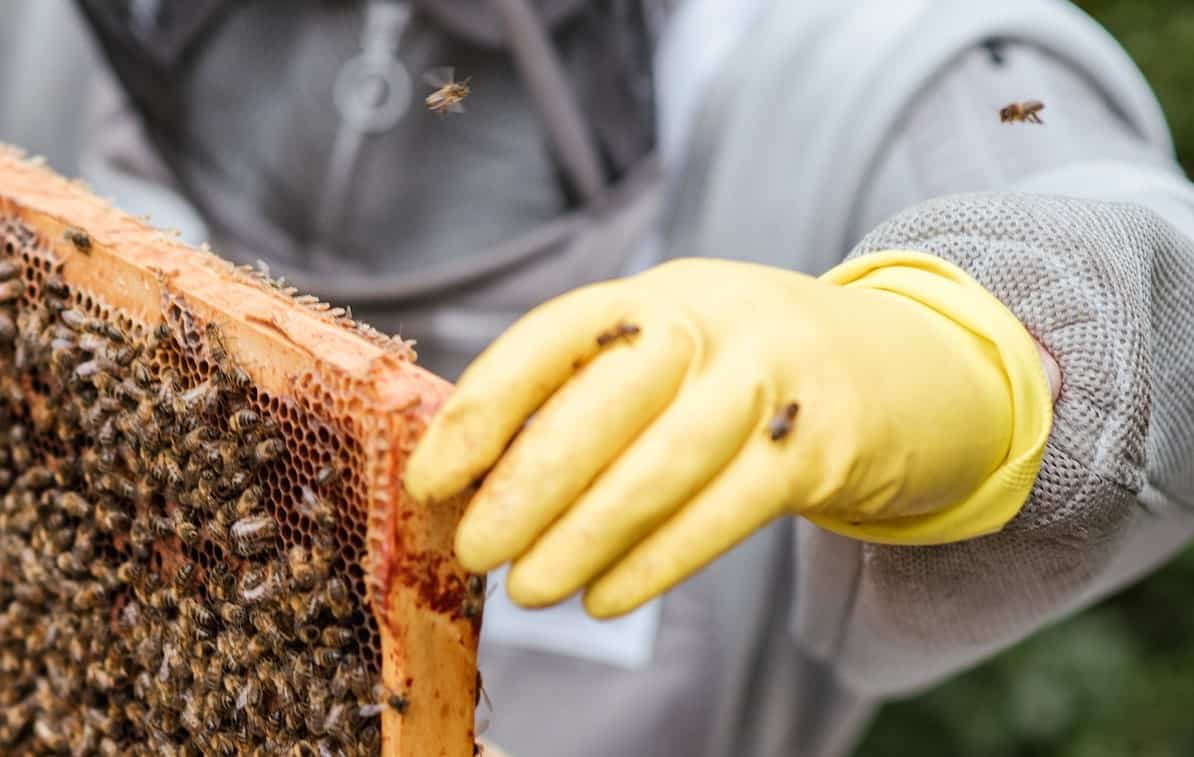
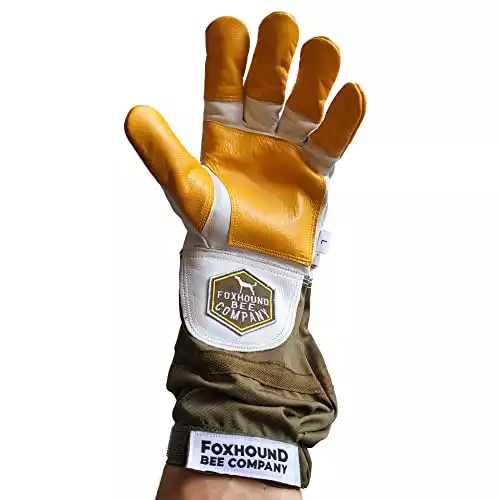
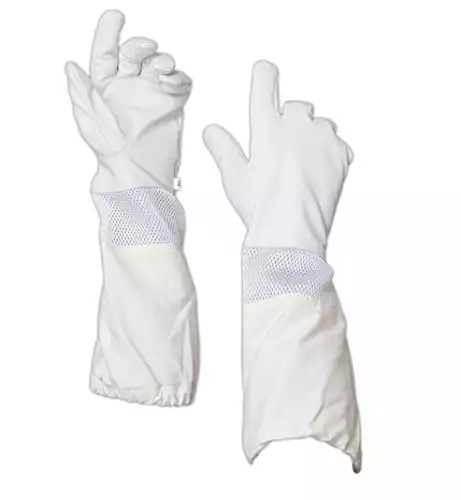
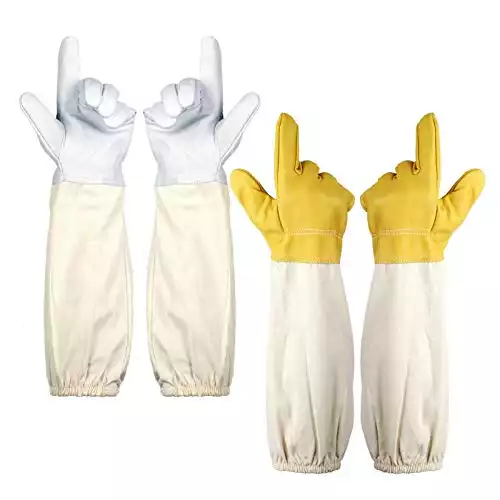
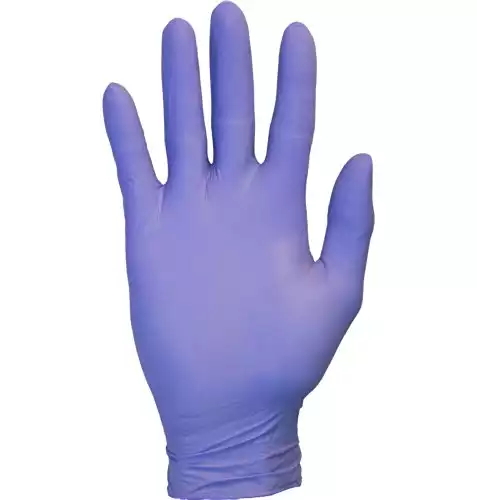
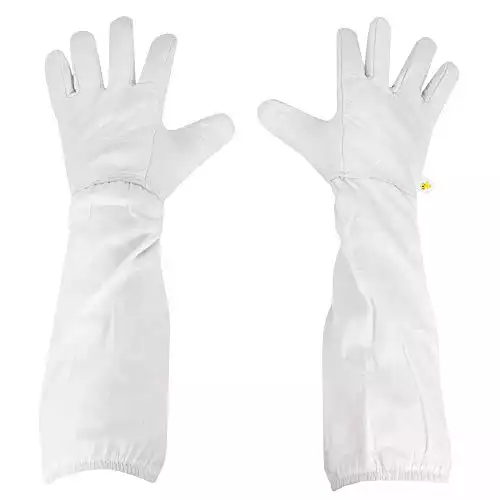
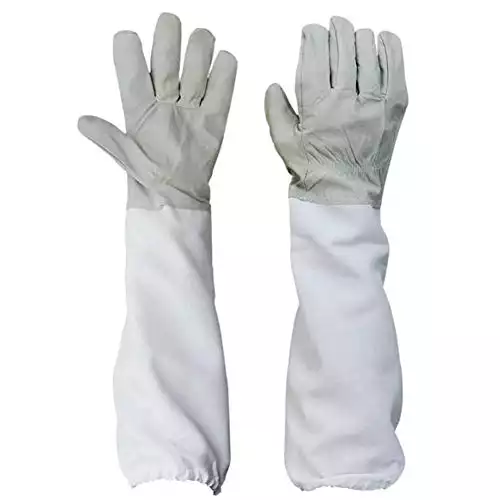
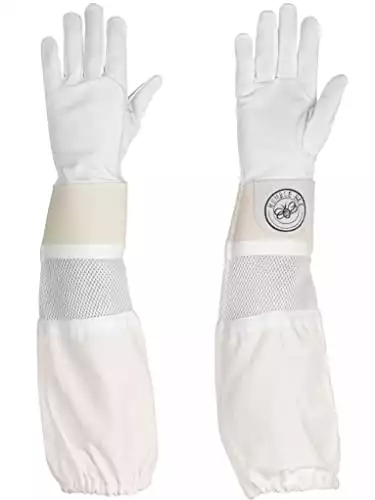
Thankyou im new to beekeeping and found this most a informing insite into glove thanks Gee
Enjoyed your opinions and agree on free choice of gloves to suit individual requirements
Kind Regards